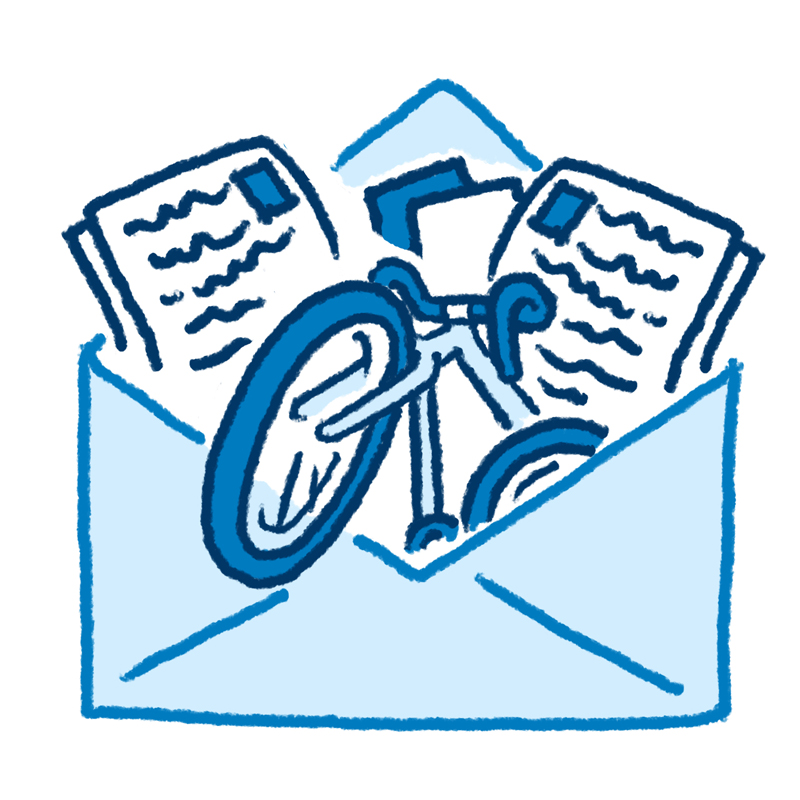Will Work From Bike
In 2022, I figured well heck, if I’m going to work remotely, I might as well get really remote!
I stuffed my backpack full of camping gear, flew to Florida, and spent the next four months through-hiking 1100 miles on the Florida Trail. Along the way, I wrote articles for magazines and websites, zeroed my inbox, cleaned out my Google Drive folders, built a website, edited a giant stack of old essays, kept a daily journal, and had the time of my life. I didn’t get rich, but I was able to cover a portion of my expenses while on trail. By the end of my trip, as I trudged through my last waist-high swamp, I realized: I am happy. And I am on to something.
There are certain people for whom office life is both alluring and devastating. I love writing and telling stories; I also go bonkers if I sit in front of a computer all day. My solution has been to take myself and my work into the wild. Call me what you want – a freelance writer, a remote worker, a content creator, a digital nomad; but really I’m just an office worker gone wild.
Last year when I returned from the Florida Trail, I immediately started planning my next trip – this time with no end date. In January I packed up my bike and camping gear, flew to San Francisco, and once again hit the road, this time on the Pacific Coast Route. I’ve been pedaling and writing ever since.
Right now I’m typing this on my phone with a bluetooth keyboard. I’m sitting on the edge of a river in northern New Mexico. I pitched this article a few weeks ago from my tent while I was bikepacking the Chihuahuan Connector. I’m writing it now as I head north on the Great Divide Mountain Bike Route. I’m creating the experiment as I go, and every day is a new puzzle. There’s no reasonable way that this absurd lifestyle and career will work for me. But I happen to love absurdity, and I’m happy out here. So maybe I really am on to something.
Over the last year I’ve learned a lot about what it’s like to work from the wild. I’m constantly adapting my gear, myself, and my plans to new situations, challenges, and opportunities. The following is a glimpse into my current systems for working from the wild.
Money
I start every trip with a lump sum of savings. Whatever I make along the way goes into a new account. When the lump sum is gone, I roll over the money from the new account. In theory, if I budget well enough this could work indefinitely. In reality, we’ll just have to see.
My friends Hazel and Maddie collect my mail and forward it to me at local post offices via general delivery. Thank you friends!!

Accounting
As a freelancer, lots of things are write-offs. Whenever I buy something, I stuff the receipt in a little bag that says “Good Vibes”. When the bag fills up with receipts, I take photos of them and record them in a spreadsheet. The receipts make good fire starters.
Route Planning
I use Ride With GPS, Gaia GPS, Maps.me, and Google Maps. I download all my maps so they’re accessible offline. On this trip so far I’ve spliced together three official routes: the Pacific Coast Bike Route, the Chihuahuan Connector, and the Great Divide Mountain Bike Route. I plan my trajectory as I go. Here’s more advice for choosing a navigation method.
Riding Distances
The key to working from the wild is taking it slow. I mean this. Writing is a real job that takes real time. Sometimes this means working in the morning and riding in the afternoon. Other times it means riding for a few days and then hunkering down and writing for a few days. This is a challenge when I meet other cyclists who I’d like to travel with but can’t because I need to stop to work. I understand this and have made peace with it, but it can still be hard in the moment.
Right now I’m riding a Kona Sutra LTD, which is reliable and great for many types of terrain.
Food
When I was back home, I dehydrated garden vegetables, fruits, and other foods and stored them in ziplock bags. Now my mom mails me packages of these foods via general delivery at local post offices. I supplement these with food from grocery stores along the way. Thank you mom!
Camping
I’m a huge fan of dispersed camping on public lands. The U.S. Forest Service (USFS) and the Bureau of Land Management (BLM) often allow free dispersed camping. Sometimes I also camp in official campsites. I camp almost every night.

Social Life
I describe myself as a “friendly introvert.” I can spend days or weeks by myself without feeling lonely; it’s also easy for me to meet new people and make friends. I keep in touch with close friends by phone, email, Instagram, and letters. On long journeys I also often feel a sense of closeness with non-human animals, plants, and all of nature. I genuinely experience nature as relational, and this means I rarely feel alone.
Where Do I Actually Work?
I often work in my tent. I also work in libraries, coffee shops, grocery stores, restaurants, public parks, campsites, and gas stations. This winter I spent several months working under an actual rock. That was probably my favorite office of all time. The rock was on a hillside and had a shallow cave underneath. Amazingly, I got cell reception. I had several officemates, including a hummingbird and a family of friendly rats.
Electronics
I usually type on my Samsung Galaxy A53 Android phone with my Zagg Flex Universal Keyboard.
The Zagg Flex Universal Keyboard also works with my iPad Mini. The iPad Mini isn’t essential, but I find it useful for desktop functions. I use it to update my website and to plan routes on apps like Ride with GPS.
It’s definitely annoying to use an Android phone alongside an iPad. However, I’ve always had an Android phone and after trying three different Android tablets, I gave up and settled on the iPad Mini. It’s the best and it’s worth the hassle.
When I hiked the Florida Trail I didn’t have the iPad yet, so I did all my desktop work on public computers at local libraries. This works too.

Protection and Adapters
I protect my phone and iPad with screen protectors and cases. For my Android phone I use an Otterbox Commuter Series Lite Case and a SuperShieldz Screen Protector.
For my iPad Mini I use an Otterbox Defender case with the plastic screen protector ripped off. I replaced the screen protector with a KCT Paperfeel Screen Protector, because it’s more comfortable.
I store my electronics in my waterproof Showers Pass Rainslinger Hip Pack or Sea To Summit Lightweight Dry Sacks.
I also carry a variety of backup SD cards and adapters, including a Vanja 3-In-1 USB Adapter and a Rankie USB Adapter. These adapters are tiny and provide redundancy for reading and moving files between devices.
Interviews and Work Flow
I always work in Google Drive. This allows me to access all my documents from any device, anywhere. I save my documents so I can work on them offline.
I record interviews by putting my phone on speakerphone and recording the conversation with my RECJOY USB voice recorder. I also record with my iPad’s voice recorder as a backup.
After I record an interview, I save it to Google Drive and transcribe it later as needed. For video chats, I attach my phone to my Kodak Tripod with an adapter that came with the tripod.
When I’m working in noisy places, my Sony Bluetooth Headphones are essential. I mostly listen to haunting violin covers of pop songs. I don’t know why. Maybe it’s an intuitive, cathartic response to my feelings about pop culture. Please feel free to give me new music recommendations.

Internet
I use unlocked devices with prepaid data chips. In my phone I have a Mint Mobile chip, which gives me access to T-Mobile. In my tablet I have a Visible chip, which gives me access to Verizon.
If I’m in an area where only one of those service providers is available (either Verizon or T-Mobile), I can still toggle back and forth between devices by using my mobile hotspot. This has been key for maximizing my access to data and phone service. In towns, I also use public wifi at cafes, libraries, and gas stations.
Power
I carry power banks and charge them with a solar panel or at outlets.
A power bank is an external battery, and mAh (milliamp hours) represents the amount of power the battery can hold.
Right now I have one 10,000 mAh Anker Powercore power bank and one 20,000 mAh Biolite Charge PD 80 power bank.
Realistically this is more power than I need, but I prefer to keep my margins for error wider rather than smaller. For reference, most people I know who do long bikepacking and backpacking trips carry 10,000 to 20,000 mAh worth of power banks, which they charge exclusively at outlets (whereas I currently carry 30,000 mAh plus a solar panel).
I charge my power banks with a 15 watt Anker PowerPort Lite Solar Panel, and supplement with outlets whenever I find them. I pay close attention to my power usage. I put my solar panel in the sun from sunrise to sunset, either at my campsite or strapped to the back of my bike. Every evening, I top off all my electronics with my newly filled power banks.
On a sunny day my solar panel can fully fill one 10,000 mAh battery bank. However, I recently damaged the panel when I flipped my bike on a sandy shoulder, so I need to replace it with a new one. Unfortunately this solar panel has been discontinued, so I’ll have to try something different.
In the future, I’ll probably consider carrying a larger solar panel and smaller power banks. This would be more efficient for extended periods of time off grid in sunny climates.
When it comes to charging, I plan for redundancy. A cable can and will eventually break. Battery banks lose capacity over time. I always carry multiple cables and battery banks. I plan out my wall chargers and cable configurations so I can charge as much as possible at one time. I am what you might call “an aggressive charger.”

Camera Equipment
My camera equipment is simple and well protected. My goal is to get the best shots in the easiest, fastest, way possible without breaking my camera.
Right now I’m using a Fuji X100V mirrorless camera with a polarizer lens filter. The camera screws onto my Kodak Tripod.
Nearly everyone I know who shoots photos from their bike eventually breaks their camera. I’m hoping to prevent this by storing mine in a large, padded case. The case means extra weight and bulk, but I’m wagering that it’s worth it in the long run if my camera lasts longer.
I’ve tried four different cases for this camera and my favorite is still this generic padded case that was actually designed to hold large camera lenses. It fits the Fuji X100V perfectly. It has velcro straps which hook directly to my handlebars.
I keep a one-liter Sea to Summit Lightweight Dry Sack tucked nearby and put the camera inside whenever it starts to rain. (The padded case is described as “waterproof” but I disagree.)
Office Equipment
Sitting and writing for long periods of time is only sustainable if I’m physically comfortable. In this case, ultralight packing is not my friend. I load my bike like a pack animal, and this is essential to making this system work for me. I am my own boss, and I don’t want to hear any complaints from me!
I plan for gear that’s rugged, reliable, and comfortable. This includes a sturdy, three-season freestanding tent (Alps Mountaineering Lynx 1), an extremely comfortable -15 degree down sleeping bag (very old Kelty, unknown model), a reliable steel twig stove (Solostove Lite), two sleeping pads (an inflatable Thermarest ProLite size small and a foam Thermarest cut to size for outdoor use), plenty of clothes, good lighting (Biolite 750 headlamp), and tons of capacity for food and water (BV500 BearVault Canister and MSR 10 Liter Dromedary Bag).

I use my Bearvault Canister for food storage as well as for a desk or a chair. It also doubles as a food cache, a washing machine, or a bucket. It protects my food from bears, rodents, bugs, and pretty much anything.
When I’m biking I attach the BearVault to my handlebars with a Revelate Designs handlebar harness with strap extensions. This is a fantastic system. It also has the added benefit of being a real life carrot on a stick: I’m always riding toward my food stash!
Coffee
I recently learned that many bikepackers go to great lengths to brew high quality coffee! If you identify as a bikepacker, shield your eyes from this section, because I’m going to explain my down and dirty approach, and it will horrify you. For everyone else: this is the absolute best way to brew coffee on the road.
Every evening I heat up water on my twig stove. Then I add a few tablespoons of coffee to my Montbell Alpine .5 liter Thermos, fill it up with the hot water, cap it, and toss it in the bottom of my sleeping bag. In the morning when I wake up, I fish the thermos out of my sleeping bag and pour myself a cup of hot coffee without even sitting up. That’s right – I drink hot coffee every morning on my side without even getting out of my sleeping bag. It’s the ultimate lazy pleasure. I’m including this in this article because if you’re an aspiring feral office worker, it’s the best gift I can give you.
Working From the Wild
Working from the wild is a challenge, but it’s a challenge that I love. I get lots of exercise and fresh air. I write stories that are authentic to me. Every day is a puzzle, and the goal of the puzzle is balance. Balance is always in motion; aspirational.
I’ve been typing on this keyboard all afternoon. Birds are swooping around me and the river flows by in a steady stream. I’m looking forward to seeing the sun set, and tomorrow I will pack up and head into a new day.


